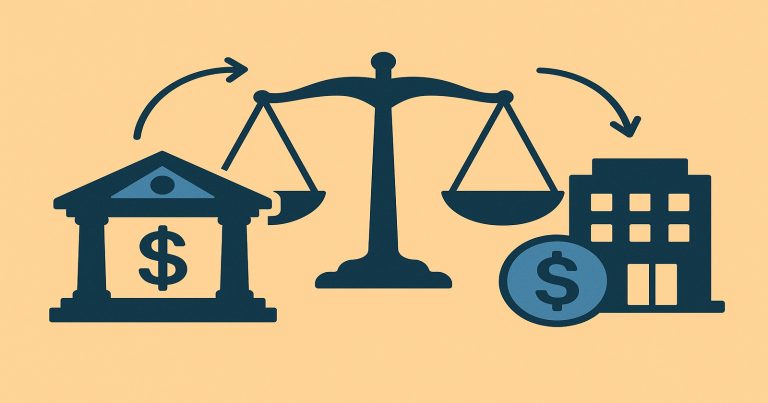Commercial and central banks are the foundation of a nation’s financial ecosystem. Though they operate within the banking sector, their goals, clients, authority, and functions differ greatly. The central bank supervises the economy, watching over financial and price stability, whilst a commercial bank is simply a for-profit institution catering to individuals and corporations. The difference between these two banks is fundamental for students of commerce, prospective banking professionals, and those working in finance to appreciate the workings of the financial system and how monetary policy affects banking services on a day-to-day basis.
Commercial Bank Definition
A commercial bank, a licensed financial institution that deals with deposit-taking and lending activities for the public, is characterised by various services, including lending, checking accounts, savings accounts, investment products, and wealth management solutions. These banks may be publicly or privately owned and regulated by the country’s central bank. Commercial banks profit by charging interest and service charges; thus, their performance affects economic activities by exerting influence over consumer spending, entrepreneurship, and capital investment. Some examples of commercial banks in India would be the State Bank of India, HDFC Bank, and ICICI Bank.
Central Bank Definition
A central bank appreciates the status of being a country’s most noteworthy monetary authority. Its central obligations include overseeing the cash supply, controlling interest rates, issuing notes, and ensuring overall economic and financial stability. Its operations are free from political impediments, even though it works closely with the government on issues related to monetary policy. The Reserve Bank of India (RBI) is India’s central bank. The RBI is additionally charged with formulating an economic policy and supervising the other banks to guarantee transparency, liquidity, and solvency within the budgetary framework.
Difference Between Central Bank and Commercial Bank
Central and commercial banks reflect the dual banking system governing modern-day economies: their purposes, powers, roles, and attendant features sharply diverge. The central bank, on the one hand, interjects as the regulatory authority in charge of money supply stability, currency issuance, and the general financial architecture; the commercial bank is a profit-oriented establishment engaging directly with the public in all matters of deposits, loans, and funds transfers. These two form the contact interface supportive of economic growth, one by regulation and control, the other by public financial services. The article explains their definition, function, characteristics, and differences.
| Aspect | Central Bank | Commercial Bank |
| Primary Role | Regulates the monetary system and maintains stability | Provides banking services to the public and businesses |
| Profit Orientation | Not profit-oriented | Profit-oriented |
| Currency Issuance | Sole authority to issue currency | Cannot issue currency |
| Clientele | Government and commercial banks | The general public and corporations |
| Monetary Policy Role | Formulates and implements monetary policy | Has no role in monetary policy |
| Loan Operations | Lender of last resort to banks | Lends to individuals and businesses |
| Examples | RBI (India), Federal Reserve (USA), ECB | HDFC Bank, SBI, ICICI Bank, Bank of America |
| Regulation | Self-regulated with the legislative framework | Regulated by the central bank |
| Ownership | Usually government-owned | Public or private ownership |
| Revenue Source | Interest from reserves, open market operations | Interest on loans, service charges, investments |
Key Capacities of Commercial Banks
Commercial banks have also been at the heart of increasing financial penetration and digital adoption, especially in semi-urban and rural areas. Via government initiatives like Jan Dhan Yojana and collaborations with fintech companies, these banks have provided formal banking services to millions who were hitherto unbanked. Their capacity to respond to changing consumer needs and integrate technology makes them active participants in the economic space.
Accepting Stores
Stores are the essential work that commercial banks perform. They mobilise reserve funds by advertising interest-based store plans like reserve funds accounts, settled stores, and repeating stores. Such stores put together the bank’s reserves for its lending and speculation exercises. In addition, commercial banks advance validity and certainty among depositors by providing a secure backup plan for store accounts under concepts like Store Protections and Credit Ensure Enterprise (DICGC) in India. This empowers family units to recognise the need for monetary education, advancing a culture of investment funds.
Lending
Commercial banks expand a wide range of advances customised to buyer needs and commercial needs: The credits are coordinated for lodging, instruction, trade extension, agriculture, and utilisation. They conduct a broad investigation of the borrower’s financial soundness, and timely reserves are discharged. Additionally, these banks provide flexible loan products such as EMI-based repayments, overdrafts, and working capital loans. Both functions are great for stimulating an economy, with the credit allowing businesses to expand and individuals to spend.
Credit Creation
Commercial banks create credit through fractional banking by lending some of their customers’ deposits. In so doing, this increases the money supply within the economy and enhances aggregate demand. This ability consequently makes commercial banks significant engines for growth within the economy. The credit creation thus extends to investment in capital goods and infrastructure, along with consumption, which stimulates production and job creation within the economy.
Facilitating Payment Systems
In modern times, commercial banks commence cashless and real-time payment transactions through NEFT, RTGS, IMPS, UPI, mobile wallets, and card-based payments. This enables seamless and efficient transactions for entities and individuals alike. The reliability and relative speed of the services have meant a tremendous drop in cash transaction reliance. Thus, commercial banks have found themselves at the forefront in promoting e-commerce and digital trades, which goes down the lane to realise the country’s digital economy ambitions.
Investment and Advisory Services
Commercial banks also engage in diversified wealth management and financial risk management by providing clients with not just loans but also insurance, mutual funds, demat accounts, and portfolio management. These services are becoming ever more popular by the day as levels of financial literacy and participation in investment continue to grow within India. They also help in client tax planning, retirement savings, and goal-based investing, thus effectively becoming their partners for all financial needs.
Key Capacities of Central Banks
Central banks have an important position to ensure stability and integrity within the constituent realms of the economic structure of nation-states. Being a monetary authority in a country, it would manage its currency, keep the inflation rate under control, and ensure the smooth running of its financial system. Hence, they become worthy institutions whose decisions cast an indelible footprint in the landscape of economies of both developed and underdeveloped nations. Interestingly, the core functions that are performed at the centres of central banks, for economic development and financial security, give substance to interest rate-setting, currency issuing, and supervision of commercial banks.
An Economic Watchdog
The central bank collects data, conducts research, and publishes reports that form the basis for guiding policymakers and financial market participants. The bank’s representation can be extended to forum-level international economic cooperation, such as the IMF and World Bank.
Formulations of Monetary Policies
The bank stabilises all monetary instruments—interests, inflation, and liquidity- by tweaking the repo rates, CRR and SLR. This is the case because the measures combined help determine the direction of economic growth while constraining inflation within specified limits. By optimising these devices, he attempts to counter economic cycles, strives to increase demand in recessions, and rejects overheating during booms. Borrowing costs, volumes of investments, and the value of a currency are greatly influenced by and dependent on one’s decisions.
Issuing currency
Only the central bank can print and issue national currency. It also maintains the integrity and stability of the whole monetary system. The notes and coins thus become legal tender. This power allows the central bank to ensure currency design consistency, measures against counterfeiting, and cash flow management across the economy. It also studies the circulation of currency and the withdrawal process for soiled or damaged notes.
Regulating and Supervising Banks
The bank also created regulations about paying off bad debts and claimed credit saturation accurately, which executes their enforcement and punishes anything outside the norm. This bank also monitors adherence to banking-related laws, besides correcting bad banks in enforcing the capital adequacy ratio (like Basel III norms). It creates transparency for stakeholders and protects the depositor.
Last Reserves Lending:
Banks with a lending interest can have emergency loans from central bank reserves when faced with a liquidity crunch or financial crisis, preventing public panic, saving depositors, and stabilizing the economy.
Maintain Foreign Exchange and Reserves
Central banks, therefore, acquire foreign exchange reserves and feature in the foreign exchange market to maintain the fluctuating exchange rates. Also, this provides measures regarding imports, exports, and international remittances transactions. Securing one’s currency against speculative attacks globally and against market volatilities is very important. In this way, currency exchange stability in the region of assured rates tends to increase investor confidence and enhance trade competitiveness.
Characteristics of Commercial Banks
Commercial banks are financial institutions around which the entire economy revolves. They receive deposits from the public and grant loans for investments, consumption, and many other purposes. Such banks channel savings into productive uses and serve businesses, individuals, and governments. Some key attributes of commercial banks include profit orientation and regulation by central banks and services such as credit creation, payment facilitation, and risk management. Understanding these features will provide valuable insights to commerce students as they are the backbone of any financial system vis-à-vis monetary policy, commercial credit availability, and economic development.
Profit Origin
Profits are generated through borrowing by charging interest on loans, petty transaction fees, selling different financial products, and so forth, to maximise shareholder value. The business model is oriented toward minimum operational costs with maximum customer retention. However, being for profit pushes these institutions to innovate, expand aggressively, and develop customer-centric solutions, all of which must be balanced with a rigorous process of risk management and ethical conduct.
Intermediation Status of Finances
They convert surplus savings into loans, thus ensuring productive use of idle funds: this helps build capital and speeds up the engine of economic activity. These roles make commercial banks the most prominent mobilisers of savings and investments directed toward sectors like real estate, infrastructure, education, and entrepreneurship.
Credit Risk Management
Banks completely appraise the credit risk using their credit appraisal systems, collateral, and rating agencies. They also keep track of the loan account at almost all times and thus continually provide for bad debts to keep the two sides of the accounts healthy. However, an effective risk management system will incorporate early warning systems, credit scoring models, and periodic stress tests. These practices keep banks afloat despite any economic gale without toppling over.
Innovation and Technology Use
Given that commercial banks invest heavily in core banking systems, AI, blockchains, and mobile apps, they can remain competitive nowadays. Banking transactions in digital form have come to be the order of the day, offering services 24/7. These innovations can improve the speed of transactions/processes and fraudulent detection. Banks have also used data analytics to personalise their offerings or drive strategic decisions.
Wide Coverage
Through the thousands and thousands of branches, ATMs, and agents, commercial banks even penetrate remote villages. True to the vision, this outreach buttresses financial inclusion and economic empowerment. The banks have moved towards further extending reach through models such as Business Correspondence and Digital Villages, making such penetration sure to see more people benefit from savings, credit, and insurance.
Exceptional Features of Central Banks
Besides issuing currency and formulating monetary policy, some features set central banks apart from other financial institutions. Their independence, supervisory capacity, and ability to secure economic stability greatly affect a nation’s financial system.
Monopoly in Currency Issuance
Only the central bank has the authority to issue banknotes and regulate the issue of such notes uniformly within the area. Thus, the government can ensure uniformity, security, and control over the supply of money, which helps prevent counterfeits and hyperinflation. Ensures a balance between adequate liquidity and not too high inflation. The central bank also has the right to determine the design and denomination of currency notes.
Policy Maker
This is the sole authority to frame an interest rate, inflation targeting, and the flow of credit in the entire economy. Thus, these policies govern every economic agent, from a mere household to a whole corporate entity. Policy direction from the central bank also affects fiscal planning, government borrowing, and market sentiment. An independent central bank can act quickly and responsively to such economic shocks.
Independence from Government
Almost all modern central banks now operate independently; in this way, they make decisions in a manner that is not interested in any political angling with data. This way, they could give a reputation to policy credibility and inspire confidence among the investors. In the past, governments and ministries of finance coordinated, but central banks were freer from such short-term political processes, thus ensuring stability for the longer term over electoral considerations.
Banker to Government and Banks
Central banks also operate the government’s accounts and any public indebtedness it undertakes. It also offers a payment service. Again, it serves as a settlement house for groups of commercial banks. This duality affords the central bank the required oversight to ensure that money transfers are funded efficiently and fiscally disciplined. For this reason, a government may borrow via open-market operations or T-bill auctions.
Providing a Stable Financial System
The central bank inspects, regulates macro-prudential, and performs systematic risk assessments to maintain a resilient financial infrastructure. It looks after financial institutions’ capital adequacy, stress testing, and liquidity management. The markets are calm and orderly, with their intervention during periods of instability.
Difference Between Central Bank and Commercial Bank FAQS
1. What is a commercial bank?
A commercial bank is a financial institution that accepts deposits, provides loans, and offers financial services to individuals and businesses to earn a profit.
2. What is the role of the central bank?
The central bank formulates monetary policy, regulates banks, issues currency, manages reserves, and ensures financial system stability.
3. What is the main difference between a central and commercial bank?
A central bank regulates the entire banking system and issues currency, while a commercial bank serves the public with banking services and focuses on profitability.
4. What are the features of commercial banks?
Commercial banks are profit-oriented, offer various deposit and loan products, facilitate payments, and promote financial inclusion.
5. Can a commercial bank issue currency?
No, only the central bank has the legal authority to issue the country’s currency.


